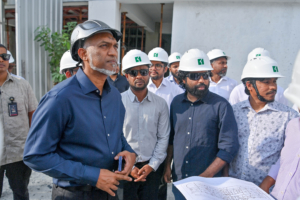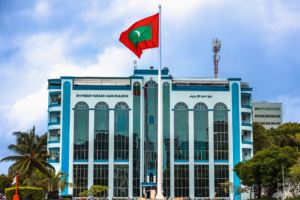Malé, Maldives – Environmental Protection Agency (EPA) on Wednesday launched a probe into the alleged grounding of a barge used for Thilamalé bridge construction on Vilimalé reef.
Three people were injured on Tuesday when the jack-up barge collided on the Vilimalé reef.
Director General of EPA Ibrahim Naeem stated that it is unclear whether the vessel has grounded on the reef, and if it did the reef would have significant damage. Authorities have been unable to remove the vessel from the location since the accident occurred while the barge was releasing its legs to station itself.
The barge has to be removed from its station to evaluate further damages to the reef.
The bridge construction project was awarded to AFCONS India, to be completed by in three phases.
Phase I of the project linking Malé and Vilimalé will be complete by July 2023 and open to the public by 15 August 2023. Phase II will connect Vilimalé and Gulhifalhu and be complete by the end of 2023. Phase III linking Gulhifalhu and Thilafushi is expected to reach completion by November 2024.
AFCONS states that the barge grounding will not affect the scheduled completion dates of the project.
Another AFCONS bridge construction project, the Addu City Hankede Bridge Project, suffered major damages due to monsoon sea swells earlier in July.
The Greater Male Connectivity Project (GMCP) includes a 6.7 km bridge and causeway network connecting Male, Villingili, Gulhifalhu and Thilafushi and as per the current government this would be a national economic engine and lifeline connecting Hulhumale’, Hulhule’ and Male’ with the proposed Gulhifalhu Port and the Thilafushi Industrial Zone.
The project is being financed through a USD 400 million loan from EXIM Bank of India and with an additional USD 100 million grant from the Indian government. The agreement between EXIM Bank of India and the Maldivian government was signed on October 12, 2020. EXIM Bank informed that this loan would include a 5-year moratorium and a 20-year repayment period for the Maldivian government.
The new bridge includes three navigation bridges of 140 meter main span across the deep channel between each island, 1.41 km of marine viaduct in deep water, 2.32 km marine viaduct in shallow water or on land, and 2.96 km of at-grade roads. Bus terminals are also planned on each island near the junctions with the mainline and the project will use solar power for road lighting, navigation lighting, deck cell lighting, CCTV and lighting on sign gantry and architectural lighting.





